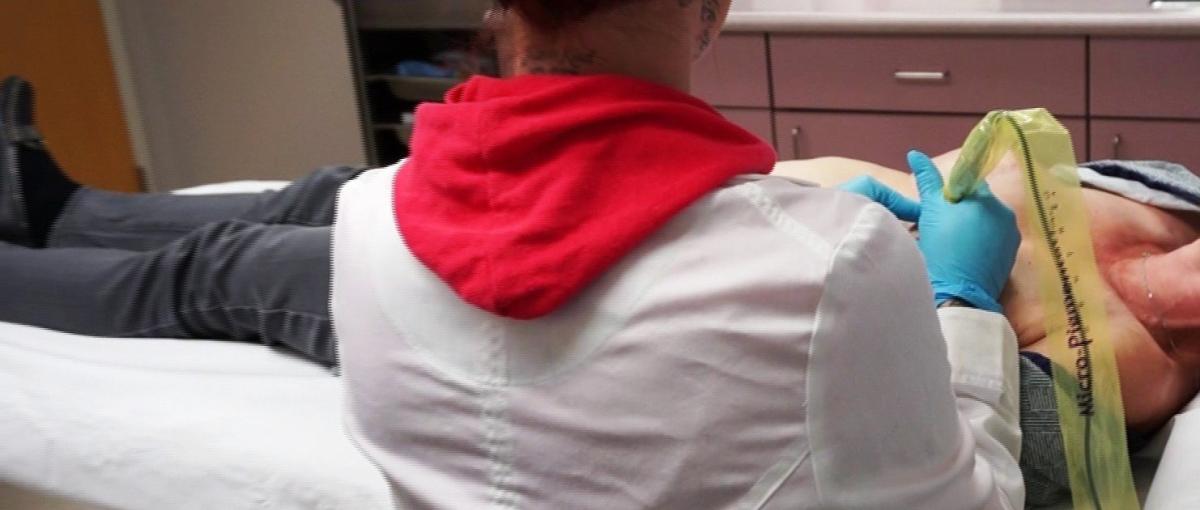Healing tattoos
Tattoo artist helps breast cancer survivors feel whole again

October 18, 2016
By Tessia Verbeek, Senior Advisor, Communications, Covenant Health
Note: This story includes images of breast reconstruction that may be sensitive to some viewers.
Katy Petty moves the buzzing tattoo needle over Donna’s breast. Dipping and mixing between small inkpots, she uses pink ink to trace a nipple and areola over each breast.
Healing tattoos are a service that people often don’t think or talk about. But for Donna, it’s a symbol of the end: the final stop in a long, emotional journey battling breast cancer.
“The surgeon told me that the last stage was nipple reconstruction or tattoos,” she says. “At first, I didn’t want either. I thought, I don’t need nipples anymore! But then I realized this is for me. It’s personal. It gives me something to focus on instead of the scars.”
Donna was diagnosed with invasive cancer in 2007. Her treatment included a lumpectomy, chemo and radiation. During a routine mammogram in 2014, they found cancer in her other breast; this cancer was a second primary, not a recurrence.
“It was just a fleck on the X-ray, but after two lumpectomies my doctor recommended I have a mastectomy,” Donna recalls.

The left breast shows the result after one tattooing session; the right breast shows the results of two sessions including today’s. Three-dimensional shadowing is now visible on the right breast.
“So I said, you know what? I want to have both breasts removed because I don't want to risk it coming back.”
Because the cancer was in situ, meaning it was contained within the milk ducts, Donna was able to have immediate reconstructive surgery. It was ultimately successful, but the radiation from 2007 destroyed her skin elasticity, and one of the implants didn’t settle. Donna had further surgery using the latissimus dorsi muscle (the large, flat muscle on the back) before she could move forward with healing.
Looking back, Donna has no regrets about trying breast-conservation surgery first, although she adds, “I wish people were aware from the get-go that radiation destroys the tissue. I didn’t understand that when I was first diagnosed so I want to help people make an educated decision.”
Now, as Katy drills indelible ink into her skin, Donna feels at peace. “I really believe in the reconstruction and tattooing and the difference it makes,” says Donna. “I can see why people don’t want more surgery after going through cancer treatment, but with time, you heal—and the outcome is so good.”
Katy dedicates one full day a week at the Misericordia Community Hospital to redrawing areolas on women who have survived breast cancer. When booked through the hospital, the sessions, including touch-ups, are covered by health care.
On the other days of the week, Katy runs her own medical tattoo business. Her services include tattooing eyebrows on patients who have lost them to chemo, camouflaging surgical marks and creating unique designs to cover up scars or stretch marks.
For areola and nipple repigmentation, Katy uses a technique called pointillism, which combines shadows and multiple colours to create the illusion of a three-dimensional nipple. She’s quick to add that because of the stippling method, it doesn’t hurt like a regular tattoo.
A typical patient needs two to four sessions, including a consultation and a final photo.
Katy studies her work one final time before nodding to Donna. “You’re done—go take a look!”
Donna swings her legs over the bed to face the mirror.
“Wow!” she says softly, her voice filling with emotion. “They look so real!”
It’s an incredible moment for Donna. It’s also meaningful for Katy.
“Medical tattoos are my passion,” she says, beaming at Donna. “Tattoos are like a storybook of people’s lives. But these tattoos, these moments—it’s so much more rewarding.”
Breast reconstruction awareness facts 2015 – 16
- Breast reconstruction surgery is continually evolving and complex.
- There are many types of breast reconstruction and which procedure a woman undergoes is depend on clinical presentation, patient history, cancer treatment, and patient preference.
- Breast reconstruction surgery numbers in the Edmonton Zone
- 95 per cent at Covenant Health sites
- 75 per cent at the Misericordia Community Hospital
- 20 per cent at the Grey Nuns Community Hospital
- 5 per cent at Alberta Health Services facilities
- At the Misericordia, when medically appropriate a patient can receive immediate breast reconstruction, which means their mastectomy and reconstruction procedures are done together.
- For patients, one surgery, one time away from family, one time off work, and one recovery is physically and psychologically beneficial and for the healthcare system, there are efficiencies and savings.
- In Alberta, approximately one in eight women will develop invasive breast cancer within their lifetime.
- Resources are available